Glucagonoma differential diagnosis

Editor-In-Chief: C. Michael Gibson, M.S., M.D. [1]; Associate Editor(s)-in-Chief: Parminder Dhingra, M.D. [2] Mohammed Abdelwahed M.D[3]
Overview
Glucagonoma must be differentiated from certain skin lesions in which necrolytic migratory erythema can be found such as acrodermatitis enteropathica, psoriasis, pellagra, and eczema. Glucagonoma should be differentiated from other causes of hyperglycemia include infection, diabetes mellitus, Cushing syndrome, renal failure, acute pancreatitis, severe stress, and prolonged fasting.
Differentiating Glucagonoma from other Diseases
Glucagonoma must be differentiated from certain skin lesions in which necrolytic migratory erythema can be found such as:[1]
| Disease | Clinical Picture | Investigations | Pictures | ||
|---|---|---|---|---|---|
| History | Symptoms | Signs | |||
| Glucagonoma[2][3][4][5] | A family history of multiple endocrine neoplasia type 1 |
|
|
|
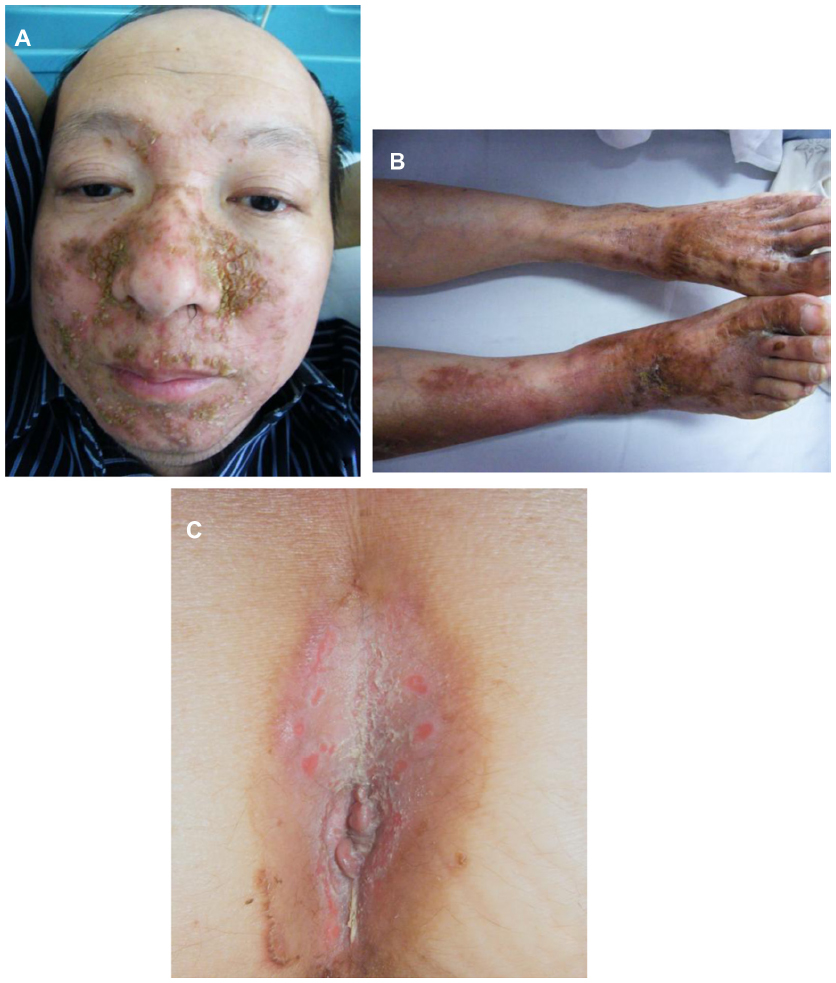 |
| Pemphigus foliaceus.[6][2][7][8] | Autoimmune blistering disease of the skin with characteristic lesions that are scaly, crusted erosions, often on an erythematous base.[1] |
|
|
Autoimmune IgG build up in the epidermis, then nearly almost all of the antibodies are aimed against desmoglein 1 | 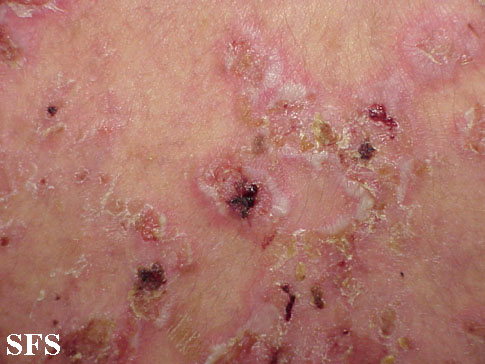 |
| Pustular psoriasis[2][3] |
|
|
|
|
 |
| Acrodermatitis enteropathica[9][10][11] |
|
|
|
|
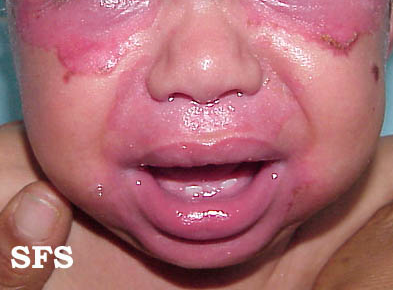 |
| Pellagra[12][13] |
|
Symmetric hyperpigmented rash, similar in color and distribution to a sunburn, which is present in the exposed areas of skin | Niacin status can be assessed by measuring urinary N-methylnicotinamide or by measuring the erythrocyte NAD/NADP ratio | 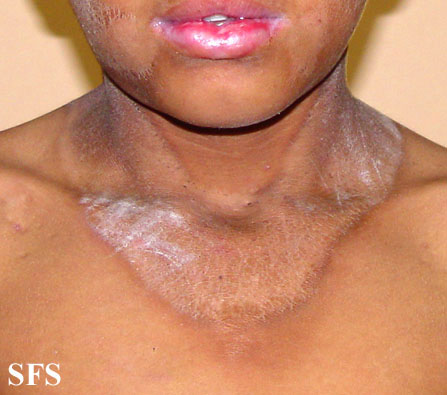 | |
| Chronic eczema (atopic dermatitis) |
|
|
|
|
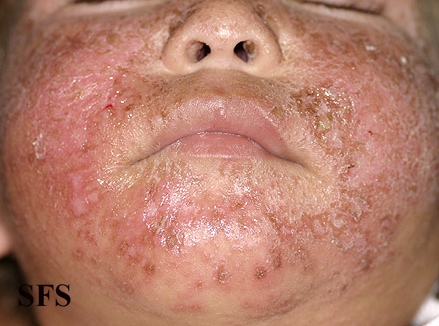 |
Differentiating glucagonoma from other causes of hyperglycemia:
Glucagonoma can be differentiated from other causes of hyperglycemia which include:[14][15][16]
- Type 2 DM
- MODY-DM
- Psychogenic polydipsia
- Diabetes insipidus
- Transient hyperglycemia
- Steroid therapy
- Renal tubular acidosis type-1
- Glucagonoma
- Cushing's syndrome
- Hypothyroidism
- Wolfram syndrome
- Alstrom syndrome
| Disease | History and symptoms | Laboratory findings | Additional findings | |||||||||||
|---|---|---|---|---|---|---|---|---|---|---|---|---|---|---|
| Polyuria | Polydipsia | Polyphagia | Weight loss | Weight gain | Serum glucose | Urinary Glucose | Urine PH | Serum Sodium | Urinary Glucose | 24 hrs cortisol level | C-peptide level | Serum glucagon | ||
| Type 1 Diabetes mellitus | ✔ | ✔ | ✔ | ✔ | - | ↑ | ↑ | Normal | Normal | N/↑ | Normal | ↓ | Normal | Auto antibodies present (Anti GAD-65 and anti insulin anti bodies) |
| Type 2 Diabetes mellitus | ✔ | ✔ | ✔ | ✔ | - | ↑ | ↑ | Normal | Normal | ↑ | Normal | Normal | ↑ | Acanthosis nigricans |
| MODY | ✔ | ✔ | ✔ | - | ✔ | ↑ | ↑ | Normal | Normal | ↑ | Normal | Normal | N | - |
| Psychogenic polydipsia | ✔ | ✔ | - | - | - | Normal | Normal | Normal | ↓ | Normal | Normal | Normal | Normal | - |
| Diabetes insipidus | ✔ | ✔ | - | - | - | Normal | Normal | Normal | ↑ | Normal | Normal | Normal | Normal | - |
| Transient hyperglycemia | - | - | - | - | - | ↑ | ↑ | Normal | Normal | ↑ | Normal | Normal | N/↑ | In hospitalized patients especially in ICU and CCU |
| Steroid therapy | ✔ | - | - | - | ✔ | ↑ | ↑ | Normal | Normal | ↑ | ↑ | N/↑ | N/↑ | Acanthosis nigricans, |
| RTA 1 | - | - | - | ✔ | - | Normal | Normal | ↑ | Normal | ↑ | Normal | Normal | Normal | Hypokalemia, nephrolithiasis |
| Glucagonoma | - | - | - | - | - | ↑ | Normal | Normal | Normal | - | Normal | Normal | ↑ | Necrolytic migratory erythema |
| Cushing syndrome | - | - | - | - | ✔ | ↑ | - | Normal | ↓ | N/↑ | ↑ | Normal | Normal | Moon face, obesity, buffalo hump, easy bruisibility |
References
- ↑ Fang S, Li S, Cai T (2014). "Glucagonoma syndrome: a case report with focus on skin disorders". Onco Targets Ther. 7: 1449–53. doi:10.2147/OTT.S66285. PMC 4140234. PMID 25152626.
- ↑ Wilkinson DS (1973). "Necrolytic migratory erythema with carcinoma of the pancreas". Trans St Johns Hosp Dermatol Soc. 59 (2): 244–50. PMID 4793623.
- ↑ Wermers RA, Fatourechi V, Wynne AG, Kvols LK, Lloyd RV (1996). "The glucagonoma syndrome. Clinical and pathologic features in 21 patients". Medicine (Baltimore). 75 (2): 53–63. PMID 8606627.
- ↑ Zhang M, Xu X, Shen Y, Hu ZH, Wu LM, Zheng SS (2004). "Clinical experience in diagnosis and treatment of glucagonoma syndrome". HBPD INT. 3 (3): 473–5. PMID 15313692.
- ↑ Kindmark H, Sundin A, Granberg D, Dunder K, Skogseid B, Janson ET, Welin S, Oberg K, Eriksson B (2007). "Endocrine pancreatic tumors with glucagon hypersecretion: a retrospective study of 23 cases during 20 years". Med. Oncol. 24 (3): 330–7. PMID 17873310.
- ↑ Bystryn JC, Rudolph JL (2005). "Pemphigus". Lancet. 366 (9479): 61–73. doi:10.1016/S0140-6736(05)66829-8. PMID 15993235.
- ↑ Chams-Davatchi C, Valikhani M, Daneshpazhooh M, Esmaili N, Balighi K, Hallaji Z; et al. (2005). "Pemphigus: analysis of 1209 cases". Int J Dermatol. 44 (6): 470–6. doi:10.1111/j.1365-4632.2004.02501.x. PMID 15941433.
- ↑ Martin LK, Werth VP, Villaneuva EV, Murrell DF (2011). "A systematic review of randomized controlled trials for pemphigus vulgaris and pemphigus foliaceus". J Am Acad Dermatol. 64 (5): 903–8. doi:10.1016/j.jaad.2010.04.039. PMID 21353333.
- ↑ Prasad AS, Cossack ZT (1984). "Zinc supplementation and growth in sickle cell disease". Ann Intern Med. 100 (3): 367–71. PMID 6696358.
- ↑ Meftah S, Prasad AS, Lee DY, Brewer GJ (1991). "Ecto 5' nucleotidase (5'NT) as a sensitive indicator of human zinc deficiency". J Lab Clin Med. 118 (4): 309–16. PMID 1940572.
- ↑ Kiliç I, Ozalp I, Coŝkun T, Tokatli A, Emre S, Saldamli I; et al. (1998). "The effect of zinc-supplemented bread consumption on school children with asymptomatic zinc deficiency". J Pediatr Gastroenterol Nutr. 26 (2): 167–71. PMID 9481631.
- ↑ Prousky JE (2003). "Pellagra may be a rare secondary complication of anorexia nervosa: a systematic review of the literature". Altern Med Rev. 8 (2): 180–5. PMID 12777163.
- ↑ Wan P, Moat S, Anstey A (2011). "Pellagra: a review with emphasis on photosensitivity". Br J Dermatol. 164 (6): 1188–200. doi:10.1111/j.1365-2133.2010.10163.x. PMID 21128910.
- ↑ Barrett TG (2007). "Differential diagnosis of type 1 diabetes: which genetic syndromes need to be considered?". Pediatr Diabetes. 8 Suppl 6: 15–23. doi:10.1111/j.1399-5448.2007.00278.x. PMID 17727381.
- ↑ Type 1 Diabetes mellitus "Dennis Kasper, Anthony Fauci, Stephen Hauser, Dan Longo, J. Larry Jameson, Joseph Loscalzo"Harrison's Principles of Internal Medicine, 19e Accessed on December 27th,2016
- ↑ "namrata".